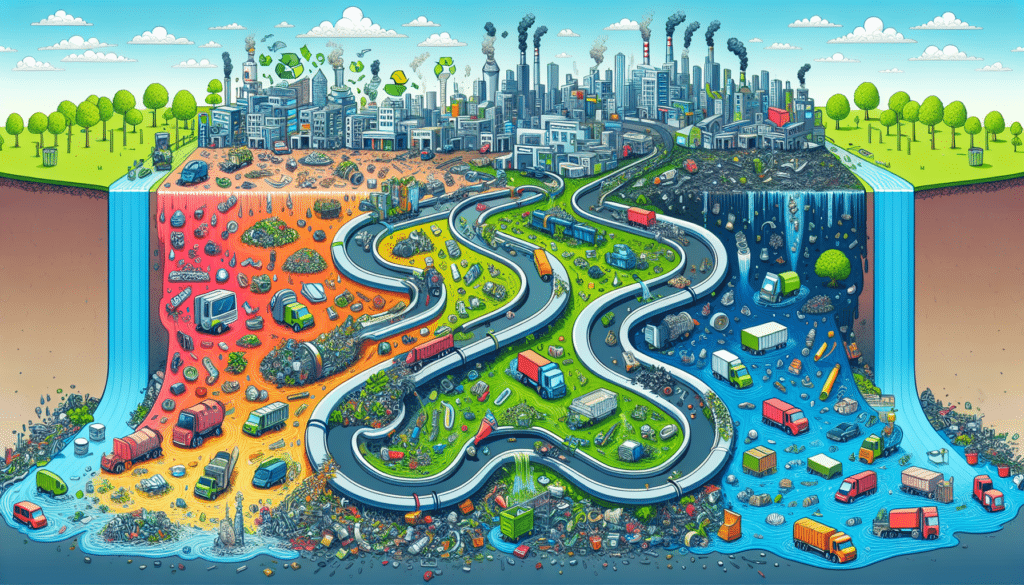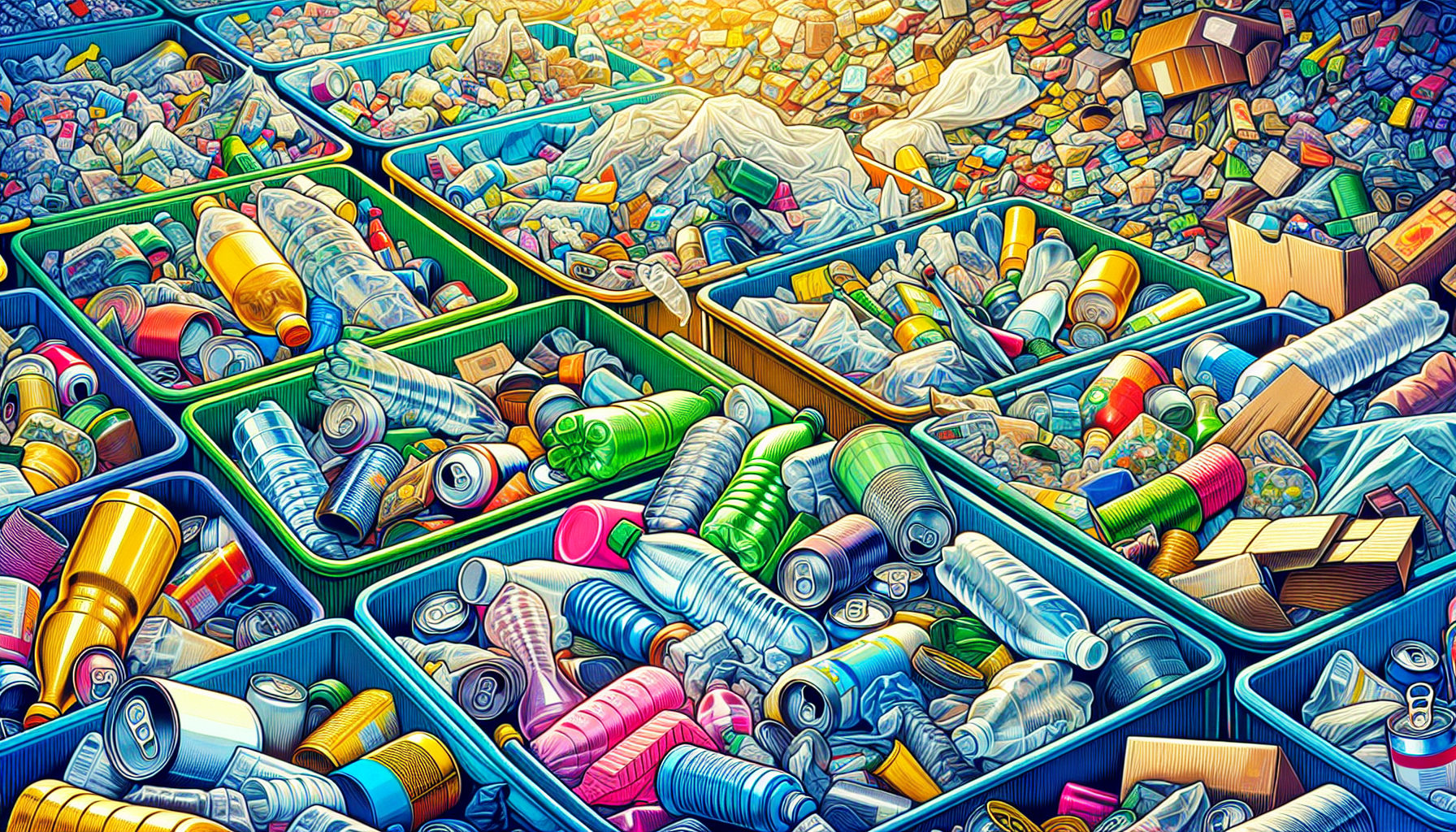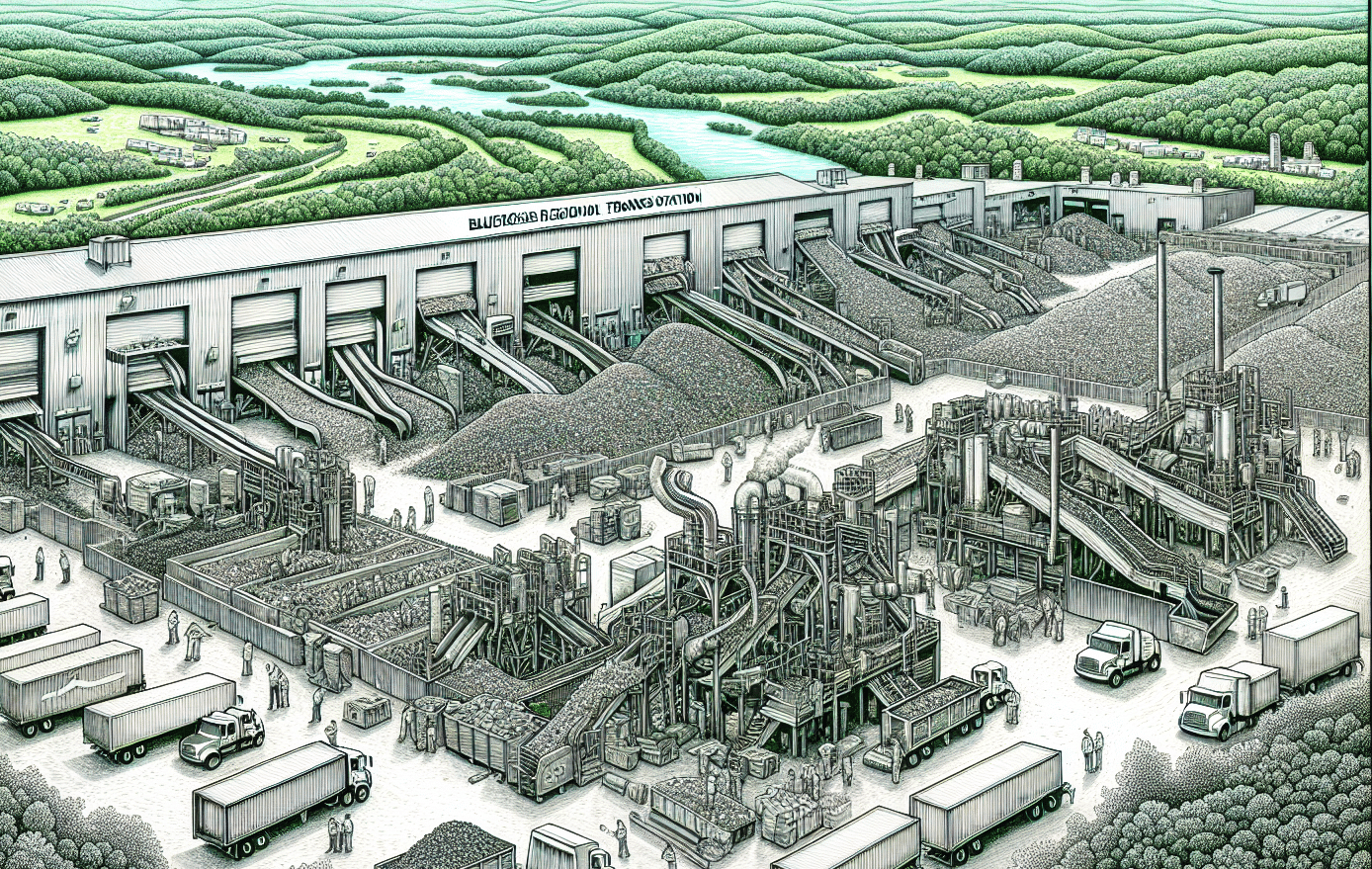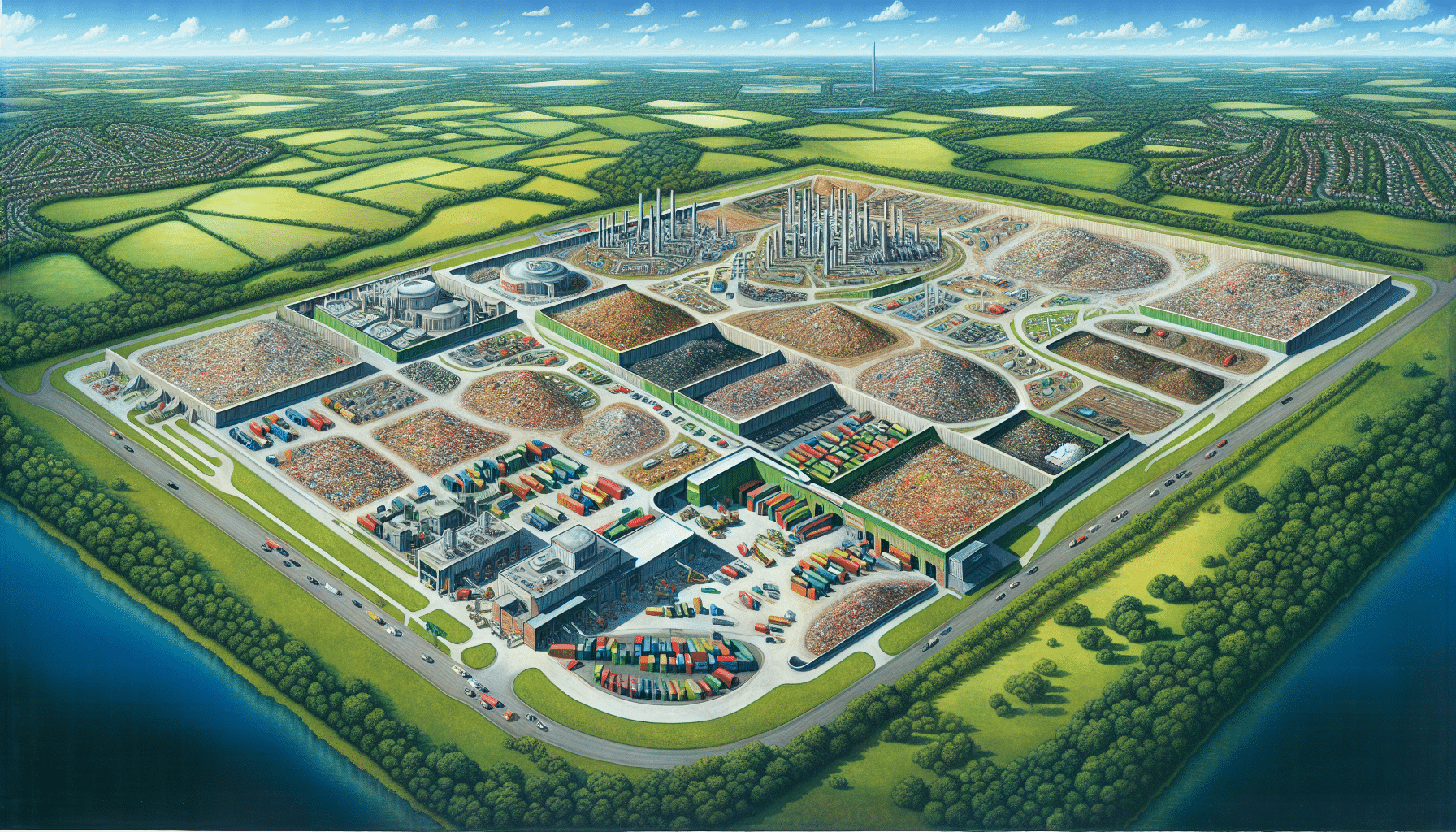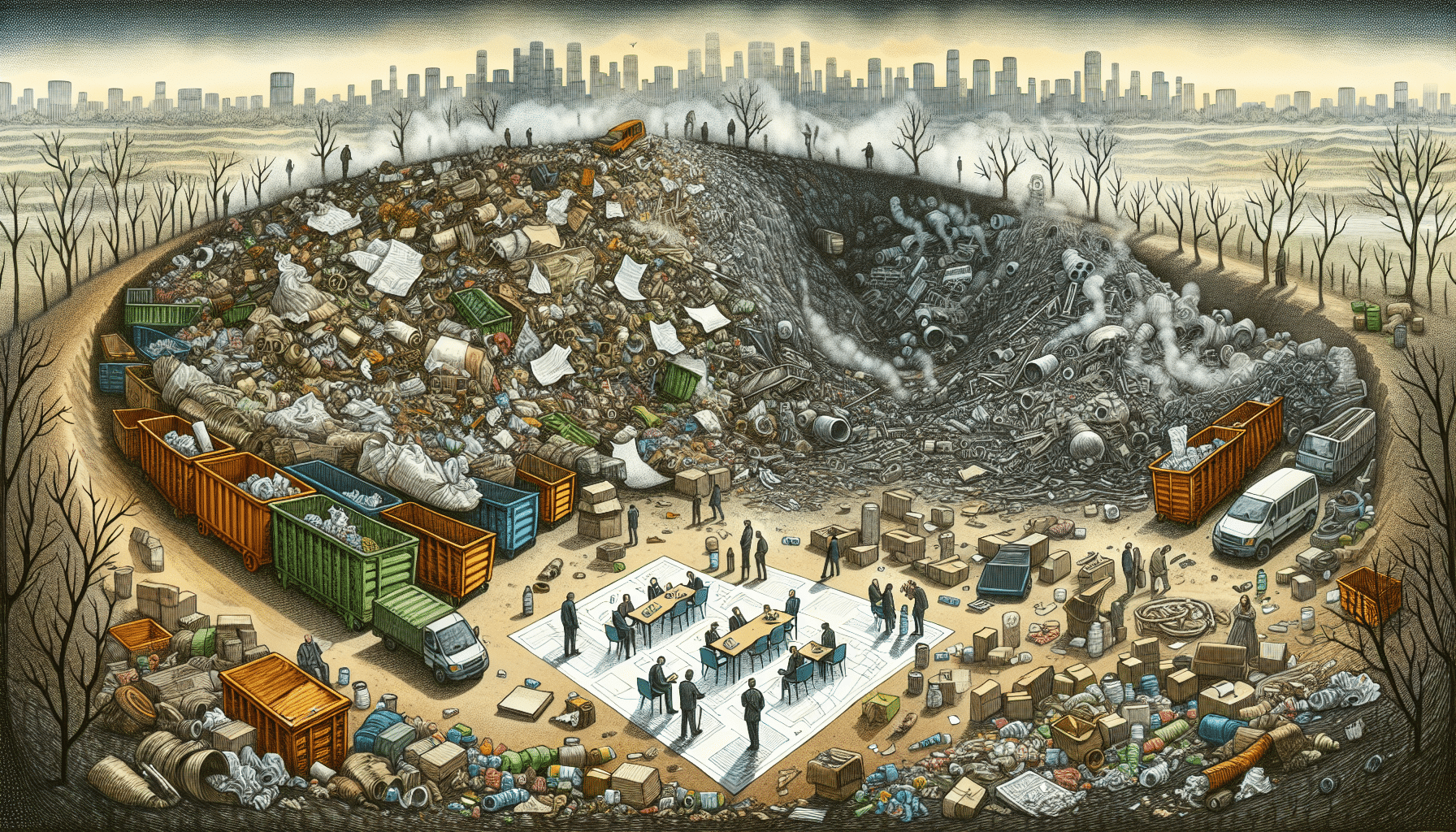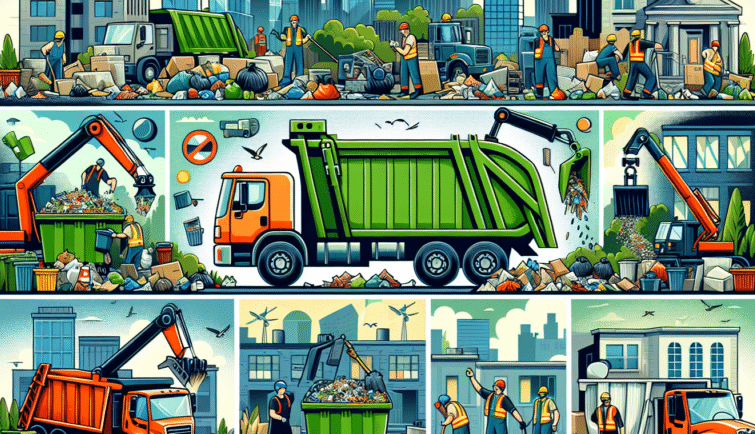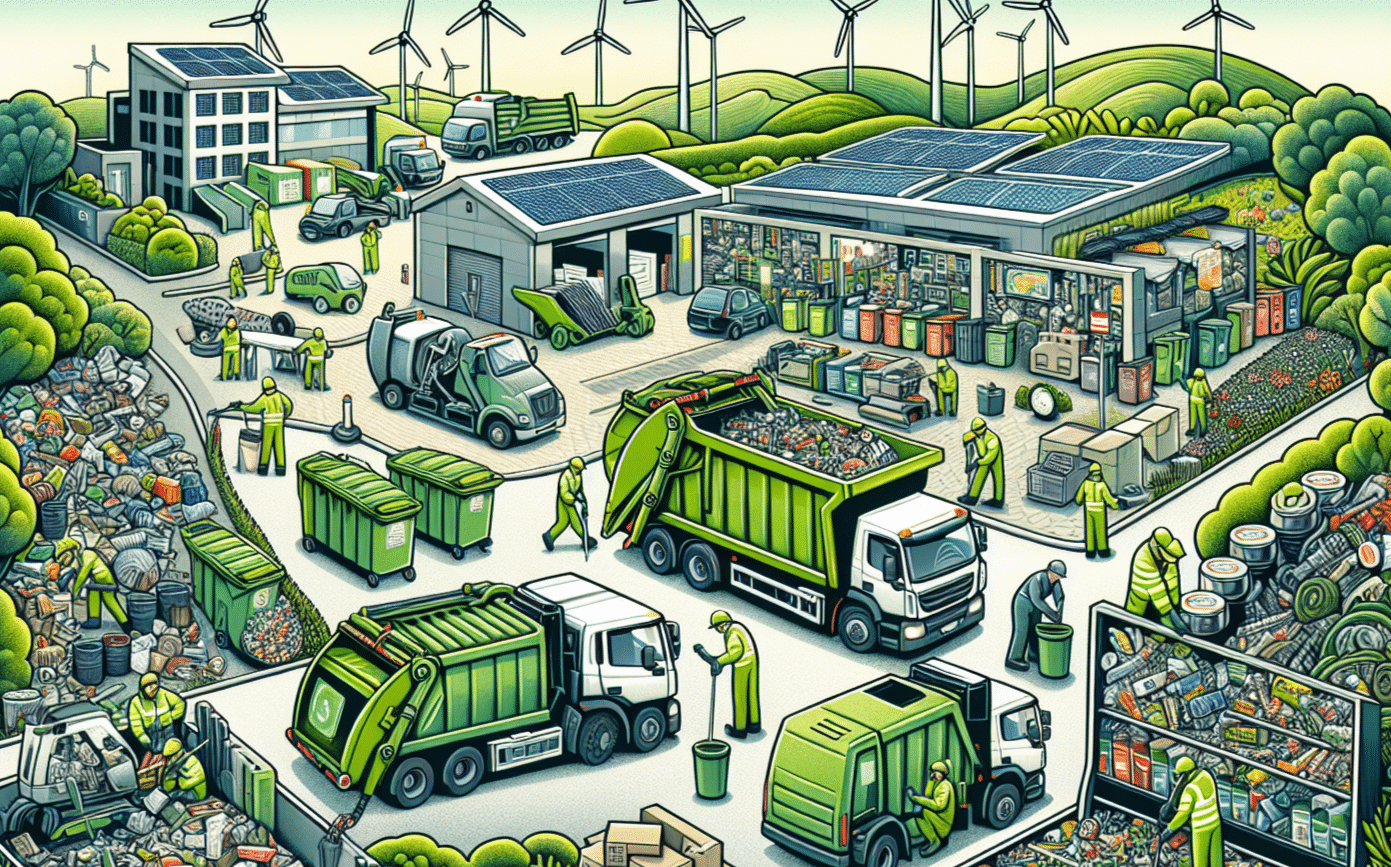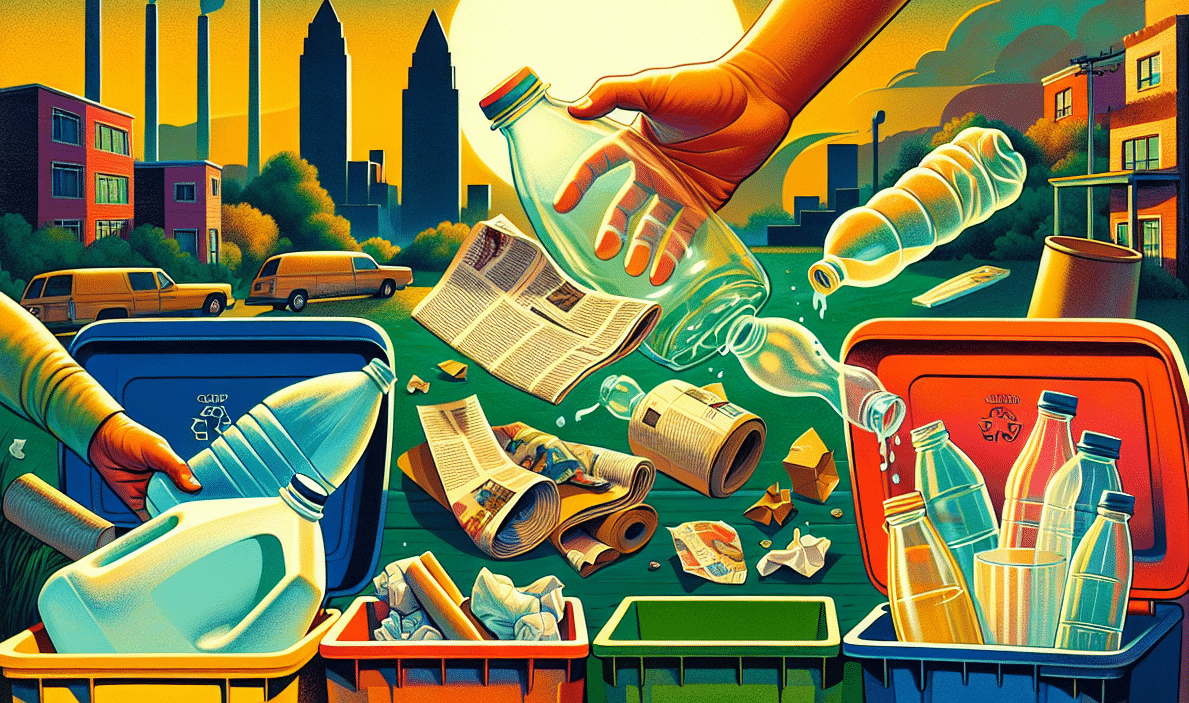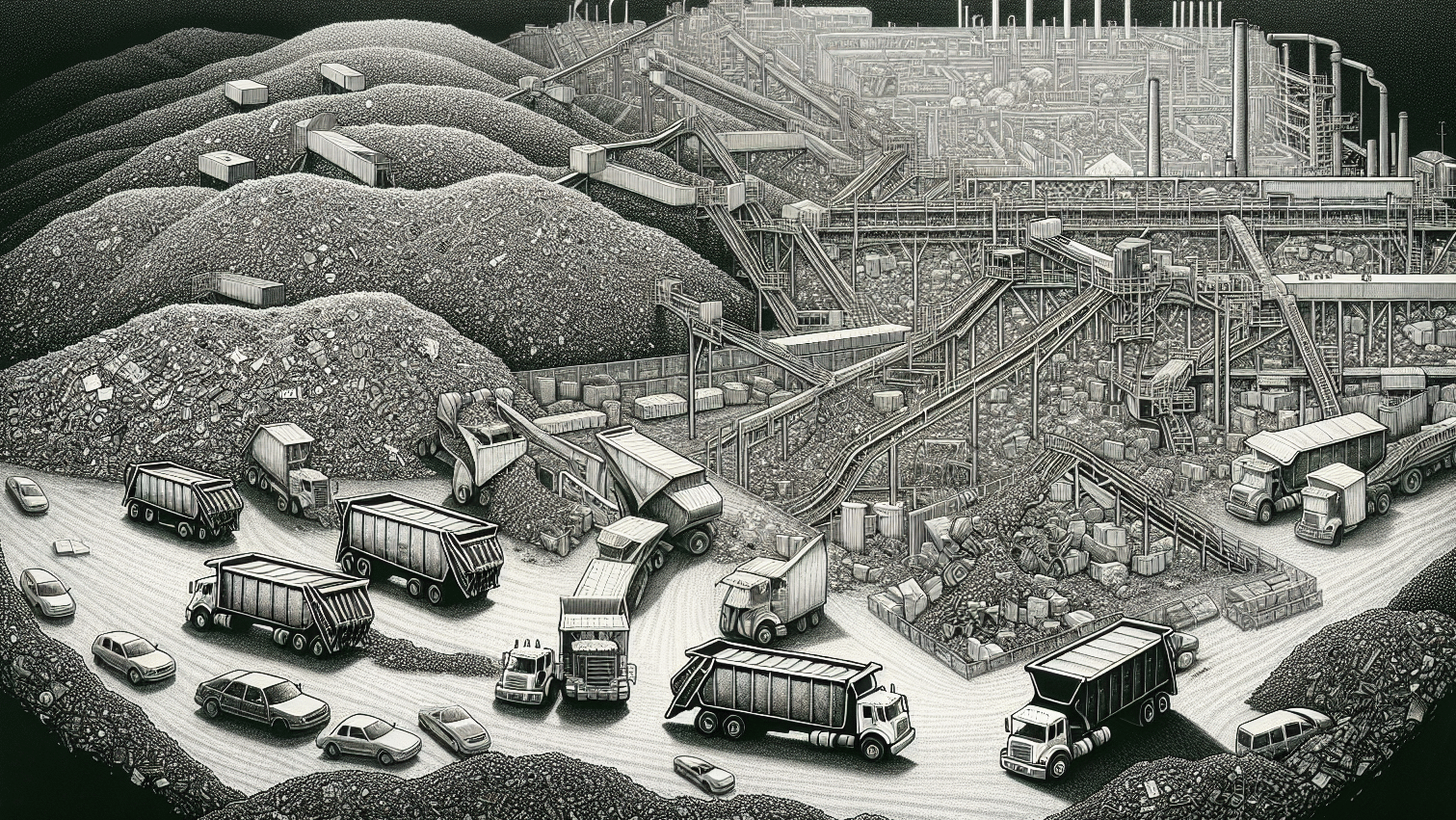A waste stream encapsulates the entire journey of waste – from the various stages of handling and treatment – to its final destination. Different types, such as municipal or hazardous waste, each follow a unique path, reflecting their impact on the environment and the importance of strategic management.
Key Takeaways
- Waste streams are the paths waste takes from its origin through its lifecycle, affecting the environment at each stage from raw material extraction to final disposal.
- Effective waste management hinges on proper segregation of waste streams and understanding their characteristics, with hazardous and non-hazardous wastes requiring different handling and disposal methods to minimize environmental harm.
- Managing waste streams effectively has financial and environmental benefits, as it can lead to operational cost savings, recycling and resource recovery, compliance with regulations, and contributes to natural resource conservation.
Exploring the Concept of Waste Streams
A “waste stream” is not a river of garbage, but a flow of waste from its origin through recovery, recycling, or disposal. We all contribute to waste streams through our daily activities, such as discarding grocery packaging to businesses disposing of industrial waste. The waste stream represents the path that waste takes, and waste management companies have the critical task of managing these streams, reducing workplace risks, and improving operational efficiency.
Not all waste streams are the same. They vary in their impact on the environment. They are categorized into product and material streams. These streams are further classified into types such as municipal solid waste, commercial and industrial waste, and hazardous waste. Each type of waste requires a specific path for efficient recycling and recovery. By streamlining these paths, we prevent unnecessary landfill usage and contribute to a less wasteful society.
To truly grasp the significance of waste streams, let’s follow the journey of a product from its raw material stage to its final disposal. Picture a can of soda. The raw materials for its production, like aluminum and corn for corn syrup, are extracted with environmental costs such as habitat destruction and pollution. These raw materials are processed into forms suitable for manufacturing, often involving pollution and significant energy use. The manufacturing phase combines various raw materials, resulting in waste and emissions. Responsible companies aim to use sustainable systems to minimize environmental impact.
Sustainable practices such as fuel-efficient transport are being adopted to mitigate any negative impact to the environment. The soda cans’ usage continues to affect the environment, prompting brands to design products that are more biodegradable or energy-efficient. Designing products for easier recycling, reuse, or upcycling can further reduce the environmental footprint.
The Lifecycle of Various Waste Streams
Municipal solid waste is home to diverse inhabitants. From discarded newspapers to obsolete electronics, these solid wastes coexist within the same stream but require different treatment paths. For instance, an old newspaper can be recycled into new paper products, while an electronic device may undergo a more complex process to recover valuable metals. This diversity underscores the need for specific stream paths for various types of waste within the municipal waste stream.
Industrial waste, with its metal scraps and chemical residues, is a more complex waste stream to manage. This complexity amplifies the importance of efficient recycling and resource recovery processes, minimizing waste volume, and maximizing value creation.
The Journey from Raw Materials to Final Disposal
Understanding the journey of a product sheds light on the intricate life cycle of waste streams. Let’s consider a plastic bottle. The raw materials for its production, such as petroleum, are extracted at a significant environmental cost, including habitat destruction and pollution. These raw materials are processed into a form suitable for bottle manufacturing, a process that often involves pollution and significant energy use.
Once manufactured, the plastic bottle embarks on a journey to reach the consumer. Sustainable practices such as fuel-efficient transport are being adopted to mitigate potential pollution from harmful fuel emissions. The use of plastic bottles continues to affect the environment, prompting brands to design products that are more biodegradable or energy-efficient.
Waste Stream Characteristics and Their Impact on the Environment
The hazard levels and recycling possibilities of different waste streams plays a significant role in their management. These characteristics determine the treatment method and directly impact the environment. Hazardous waste streams, such as lab chemicals and pesticides, require careful storage and management in specialized facilities due to their high potential for environmental harm.
On the other hand, agricultural waste streams pose challenges for management and disposal due to contamination from elements and difficulty in incineration. Segregating waste streams, therefore, is crucial for efficient recycling and disposal, helping to reduce contamination and enabling more effective resource recovery. By implementing effective waste management solutions, such as recycling, harmful pollutants are prevented from being released. This not only protects natural resources but also reduces businesses’ and communities’ environmental footprint.
Examples of Waste Streams in Action
From packaging waste to construction debris, every waste stream tells a unique story. Commercial and industrial waste streams, for instance, are generated by a wide array of sectors, including education, retail, and corporate offices, each with its own unique waste management requirements. The management of diverse waste streams reflects the broad challenge of handling waste efficiently and sustainably across different industries and business types.
From Packaging to Energy Recovery: A Stream Example
Packaging waste is a common sight in our daily lives. Product packaging waste is primarily made up of paper and cardboard, glass, plastic, wood, and metal. These materials are the main contributors to the waste generated from packaging. In the transportation industry, packaging materials used in maintenance and warehousing activities can be effectively managed, with many being recycled or reused.
LDPE film waste from agriculture, on the other hand, can undergo source reduction, recycling, resource recovery, and incineration. These processes ultimately allow for the generation of energy through incineration. This is a perfect illustration of how a waste stream can be transformed into a source of energy, highlighting the potential of effective waste management.
Construction and Demolition Waste: A Case Study
Construction and demolition waste is a unique beast. Partially natural and potentially hazardous, it contains recyclable components like wood and asphalt. A prime example of successful management of this waste stream is the Earthquake Demolition Recycling Program in Los Angeles. Following the Northridge earthquake in 1994, the program diverted roughly 1.6 million tons of debris from landfills.
In San Jose, the Zanker Road Landfill and Materials Processing Facility recycles over 400,000 tons of construction and demolition debris annually. Even on a smaller scale, individual construction projects can make a difference. For example, a construction project at Oak Elementary in Los Altos, California, ensured that 60-65% of the generated waste was recycled instead of being landfilled.
However, not all construction and demolition waste is recyclable. For non-recyclable C&D waste, management options include waste-to-energy, incineration, or landfill burial. This underscores the need for a diverse range of waste management strategies, tailored to the specific needs of each waste stream.
Segregating Waste Streams for Efficient Management
Let’s now delve into the nuts and bolts of waste stream management. A crucial aspect of this process is segregation. Proper waste segregation involves procedures such as waste separation, pairing recycling and trash containers for convenience, and establishing clear signage for individual waste materials.
Having a well-trained team that understands the importance of these processes is equally important. By training employees, businesses can ensure they engage with sustainability goals and procedures.
Identifying Hazardous vs. Non-Hazardous Waste
Knowing what hazardous and non-hazardous materials you are dealing with is the first step to effective waste management. Hazardous waste includes materials like lab chemicals, insecticides, and pesticides due to their potential harm to the environment or human health. The EPA identifies hazardous waste through a process that assesses if waste is solid, examines its composition, and determines if it exhibits characteristics such as toxicity or reactivity.
On the other hand, non-hazardous waste refers to items such as construction debris and routine commercial trash, which do not pose significant threats and abide by different disposal guidelines. Sorting out hazardous from non-hazardous waste is a crucial step for proper waste management and regulatory compliance.
The Role of Containers and Labels in Waste Stream Segregation
Containers and labels provide a means for proper identification and management of various types of waste such as electronic waste, gaseous wastes, and liquids. Think of them as signposts guiding the journey of waste, ensuring it reaches the right destination.
The Financial and Environmental Benefits of Managing Waste Streams
Managing waste streams effectively, in addition to being environmentally conscious, simply makes good business sense. Effective waste management solutions can decrease operational costs for businesses, leading to a reallocation of resources to more revenue-generating projects. Overall, correct waste management practices can result in lower energy consumption and savings on energy expenses, due to diminished need for energy-heavy disposal methods.
By segregating waste, companies can decrease their environmental footprint and increase the amount of materials that are recycled, leading to a lower environmental impact. Proper waste management positively influences natural resource conservation and protects public health by reducing environmental harm. Even the recyclability of metals can deliver significant energy and cost savings, adding to the financial and environmental benefits of waste stream management.
Reducing Volume, Increasing Savings
Reducing waste at the source is the most effective strategy for waste prevention, with practices such as encouraging double-sided printing to reduce paper use. Businesses can also save money by identifying valuable recyclables, minimizing waste management costs, and reducing the amount spent on new materials. Even cities have benefitted from waste reduction. For instance, Los Angeles, California, recycles old paving materials into crushed road base and new asphalt, saving $14 million in its first nine years.
Recycling and Resource Recovery as Value Creation
Recycling and resource recovery can generate revenue and contribute to environmental sustainability. Recycling and selling segregated waste materials such as metals, cardboard, and plastics to scrap dealers or recycling centers can generate revenue. Resource recovery of plastics can also generate financial returns through landfill-equivalent tipping fees or by selling the produced energy.
Workplace recycling programs can result in:
- Direct savings, as recycling sacks are typically cheaper than general waste ones.
- Contribution to environmental sustainability.
- Reduction of operational costs by minimizing the use of single-use plastics and paper.
Implementing Effective Waste Stream Processes
A dedicated waste management team with defined responsibilities ensures accountability and proper oversight of waste processes. Assessing existing waste disposal methods allows for the recognition of strengths and weaknesses, providing direction for refining waste management strategies. Selecting the right waste management partners is also critical for the responsible handling of waste in line with an organization’s sustainability objectives.
Assessing Your Business’s Waste Stream Volume and Types
Conducting a waste audit is a vital first step in determining the types and amounts of waste a business generates, and it can uncover points of excessive waste production. By studying a business’s waste stream, setting clear waste reduction goals, and educating staff to ensure adherence to the new policies, businesses can effectively reduce their waste.
Creating a waste management plan requires identifying the types of waste produced, their volumes, and origins within the facility, which allows for strategic waste management. Identifying different waste streams within the facility is important for regulatory compliance and for developing targeted disposal practices for each waste type.
Streamlining Operations for Better Waste Handling
Streamlining operations can significantly improve waste handling. Consider the use of IoT technology, including smart sensors and IP cameras, to optimize the collection and recycling of packaging waste, advancing decision-making and maintenance processes. Major waste management companies have implemented smart sensors to proactively monitor fleet maintenance and operating data, reducing downtime and operational waste. Efficient waste management solutions allow businesses to:
- Allocate fewer resources to cleaning up waste-related issues.
- Enhance economic efficiency.
- Avoid compliance issues.
- Optimize operations.
- Update waste management strategies in line with current disposal regulations.
- Seek expert advice for handling waste activities from collection to landfill.
The Regulatory Landscape of Waste Streams
Navigating the world of waste streams can be a daunting task, especially when it comes to understanding the comprehensive legal and regulatory framework, which includes a variety of federal, state, and local regulations. At the federal level in the United States, the primary law governing the disposal of solid and hazardous waste is the Resource Conservation and Recovery Act (RCRA). However, the regulatory landscape doesn’t stop there. The Hazardous and Solid Waste Amendments add additional regulatory requirements and provisions to the RCRA, particularly for hazardous waste management practices. At the state level, regulations may be more stringent than federal requirements, affecting how waste streams are managed within the state.
Companies must adhere to these regulations to avoid legal penalties, including fines and mandatory corrective actions, which can be costly and impact operational efficiency. Non-compliance with waste stream regulations can also lead to reputational damage that can affect a company’s market position and stakeholder relationships.
Understanding Legislation Surrounding Waste Streams
Understanding the legislation surrounding waste streams can be difficult, yet manageable. For instance, waste is required by the Environmental Protection Agency to be classified as either hazardous or non-hazardous, with each category requiring different disposal methods. The EPA identifies hazardous waste either as listed wastes, which are specifically named, or as characteristic wastes, which are classified based on properties such as corrosivity, flammability, toxicity, and reactivity.
Different waste streams follow specific legal frameworks. For instance, in the EU, waste streams are categorized into material-based classes, like metals and plastics, and product-centered classes, including electronics and end-of-life vehicles, each regulated under particular legislation. Understanding these frameworks is crucial to ensure proper waste management and compliance with regulations.
Navigating Compliance for Your Waste Management Practices
Navigating compliance for waste management practices can be made easier by staying informed and seeking expert advice. RCRA Online is an electronic resource that provides essential publications and guidance for staying compliant with regulations covering non-hazardous, hazardous, and medical waste management. This resource can be a handy tool for businesses looking to streamline their waste management practices and ensure they are up-to-date with the latest regulations.
Summary
In our journey through the world of waste streams, we’ve explored their definition, lifecycle, and environmental impact. We’ve seen how they are managed in different sectors, learned about the importance of segregation, and delved into the financial and environmental benefits of effective waste management. We’ve also navigated the complex regulatory landscape and highlighted tools to aid in compliance. With the right knowledge and strategies, individuals and businesses can turn waste stream management into an opportunity for cost savings, regulatory compliance, and environmental stewardship.
Frequently Asked Questions
What is a general waste stream?
A general waste stream, also known as a landfill, consists of non-recyclable rubbish that does not decompose and has low moisture content.
What is a process waste stream?
A process waste stream refers to the entire lifecycle of waste, from its creation to final disposal, and is segmented by type for effective waste management.
What is the most common type of waste stream?
The most common type of waste stream is general waste, which includes everyday rubbish like food packaging, laminated paper, and tissue paper.
What is an industrial waste stream?
An industrial waste stream refers to the solid waste material generated by a specific manufacturing process or client, or by a specific processing unit at a facility.
Why is waste stream management important?
Waste stream management is important because it reduces workplace risks, improves operational efficiency, and minimizes environmental impact.
